BBVA Continental, a history that goes hand-in-hand with the country
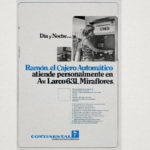
A country's history can be written based on its institutions and on what they represent for the lives of its citizens. In the second half of 20th century, the estates surrounding the Peruvian capital slowly gave in to the development vigor of a growing city with new needs and demands.
Banco Continental started operating on October 9, 1951 in a traditional building located at Calle General La Fuente, in downtown Lima. Its initial capital was 45 million soles, which in 4 years enabled it to open three new branch offices. In parallel to Lima's expansion, Banco Continental opened the first branch office at Calle Capón, where Chinese migrants developed the busy commercial area.
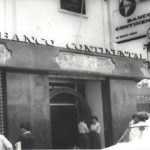
Old logotype of Banco Continental in Perú, which started in 1951
Another branch office was opened in 1955 in Surquillo, where a large number of workers and employees eager to access a better life settled. The bank's third branch office was opened in El Callao, the country's biggest port, which thanks to automobiles was no longer a remote province.
The world of the 1960s was shaken by The Beatles, “Che” Guevara and May in France. But also by the widespread ambition of conquering the future, with the first man to reach the Moon, Claudia Cardinale's bikini or the atomic tests in the seas of Hawaii. Peru was no exception to these times of renewal. Swinging from military juntas to democratic processes, the country then sought to become part of that electronic, modern and cosmopolitan world.
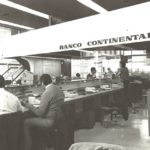
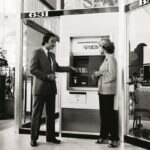
The first ATM in Peru was called Ramón. It was installed in the headquarters of the bank in1982
The bank's visionary spirit was also reflected in its technological vocation, one of the master lines it has followed to the present day. In 1967, Banco Continental started to put information to work using IBM processors, a novelty in the country. By 1973, its soundness was expressed by its 600 million dollar capital and the strength of its operations, supported by the trust of its thousands of customers.
In 1982, the bank reasserted its forward-looking approach with the installation of the first ATM in Peru. An ATM with a name: Ramón. Although some thought this was a historical reference to the Egyptian god Amon-Rá, father of the sun and the wind, the name came from the simplification of the expression in English that described its work: Rapid Money.
Aware that its commitment to the country went beyond the economic sphere, Banco Continental created Edubanco, Fundación para el Fomento de la Educación y la Cultura, which starting in 1972 promoted notable editorial projects. Ten years before, Banco Continental had also launched the first art exhibitions at its galleries.
Today, this work that includes all expressions of art -film, theater, photography, music and literature- is taken on by the BBVA Continental Foundation. The Foundation's emblematic program is currently “Leer es estar adelante” (Reading means keeping ahead), which promotes, along with the support of the State and private companies, reading comprehension campaigns at schools in the country's most humble and remote areas.
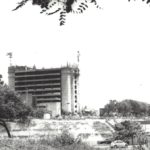
Appearance of the construction of the well-known BBVA Continental building in 1979
As the city expanded, the bank had to condition new headquarters. Construction of the building in Córpac, San Isidro, started in 1979. An imposing construction only a few meters from the old Limatambo airport, today's headquarters of the Ministry of the Interior. The building stands on what was the only drive-in cinema that operated in Lima and today is the indisputable landmark of the city's financial district.
The German model Claudia Schiffer came here in 1995 to take part in a fashion show at the bank's headquarters, as the institution's image. Those were the days of the supermodels, an unrepeatable generation of deities of the catwalks that turned top models into superstars.
It was not until the end of the 1980s that the discussion about a liberal State and a market economy was addressed. The strong opposition of the writer and Nobel Prize for Literature Mario Vargas Llosa to the attempt to nationalize the banking and financial system was the catalyst for leaving aside the national model and starting a number of reforms in public administration. Ideas that strengthened in the 1990s and created a favorable atmosphere for the privatization of many companies.

In this context, in 1995, Banco Continental was acquired by Banco Bilbao Vizcaya (BBV) and the Peruvian group Brescia. This resulted in the creation of BBV Continental, with 22.57% of the total assets of the country's banking system. Today, after becoming BBVA Continental –with the incorporation of Banco Argentaria in 1999—, it is the second largest financial institution in Peru, with over 300 branch offices in the country and nearly 6,000 employees. Peru started the international expansion of BBVA, which today is present in 34 countries and has more than 110,000 workers worldwide.
Today, BBVA Continental has become a benchmark company in the country not only for its economic results, but also for its high indices of reputation, that make it a trusted bank for all Peruvians. There is also the intense process for digitizing products and services that will contribute to make a reality the purpose that drives the wishes of the thousands of people who work at this institution: to bring the age of opportunity to everyone.
